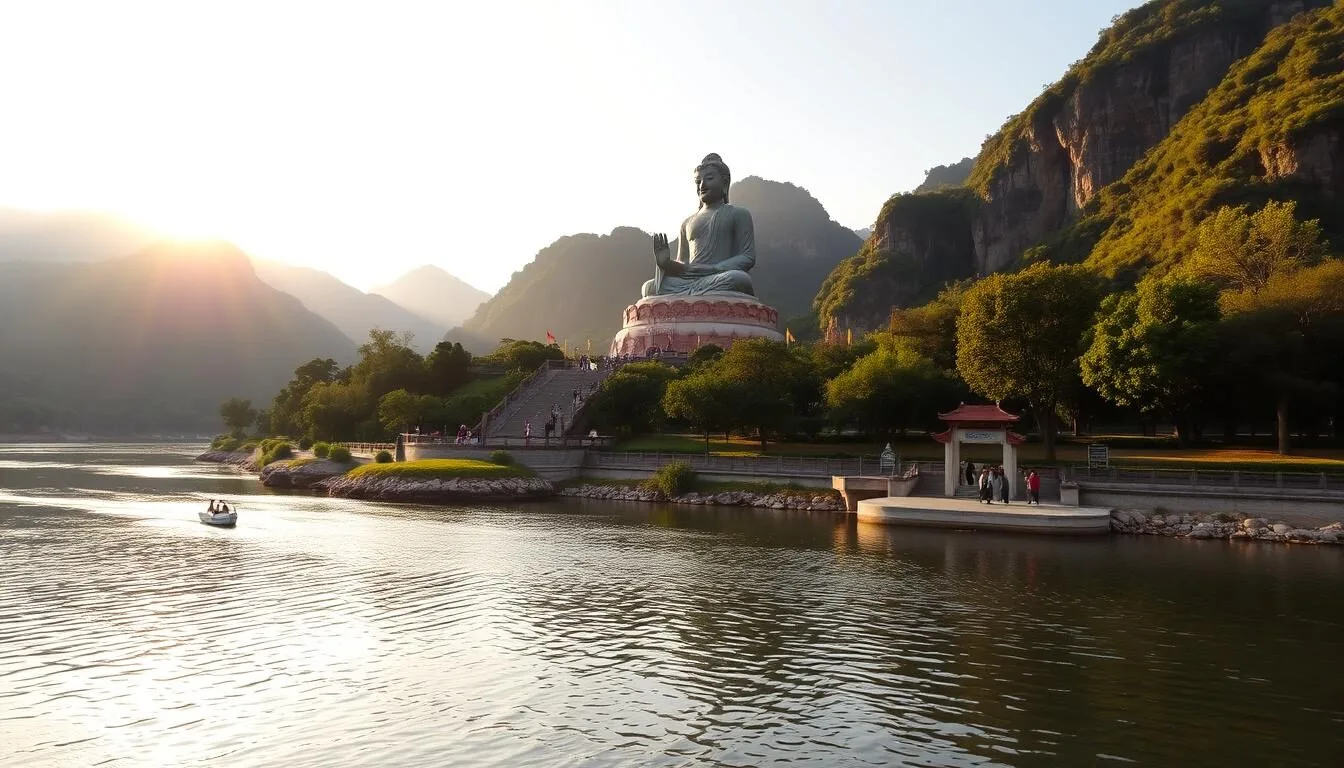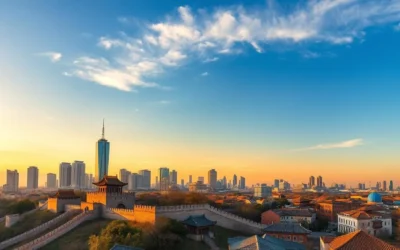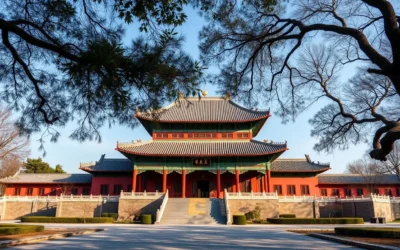✓ Accommodations✓ Flights✓ Rental Cars
You may not know that Leshan is home to two UNESCO World Heritage sites, the Leshan Giant Buddha and Mount Emei, which were recognized in 1996.
As you plan your visit to this picturesque city in China’s Sichuan province, you’ll find a perfect blend of natural wonders, cultural heritage, and spiritual experiences. The city is a gateway to breathtaking scenery and ancient religious sites.
With its rich tapestry of temples, natural formations, and local experiences, Leshan is a destination that offers something for every type of traveler looking to experience authentic China.
Discovering the Charm of Leshan
Discover the charm of Leshan, a city that seamlessly blends cultural heritage with breathtaking landscapes. As you plan your visit, understanding the location and the best time to visit Leshan is crucial for a memorable experience.
Where is Leshan Located?
Leshan is situated in the Sichuan Province of China, at the confluence of the Dadu, Qingyi, and Min Rivers. This strategic location has contributed to its historical significance and natural beauty. The city’s proximity to Mount Emei, a UNESCO World Heritage site, adds to its appeal as a tourist destination.
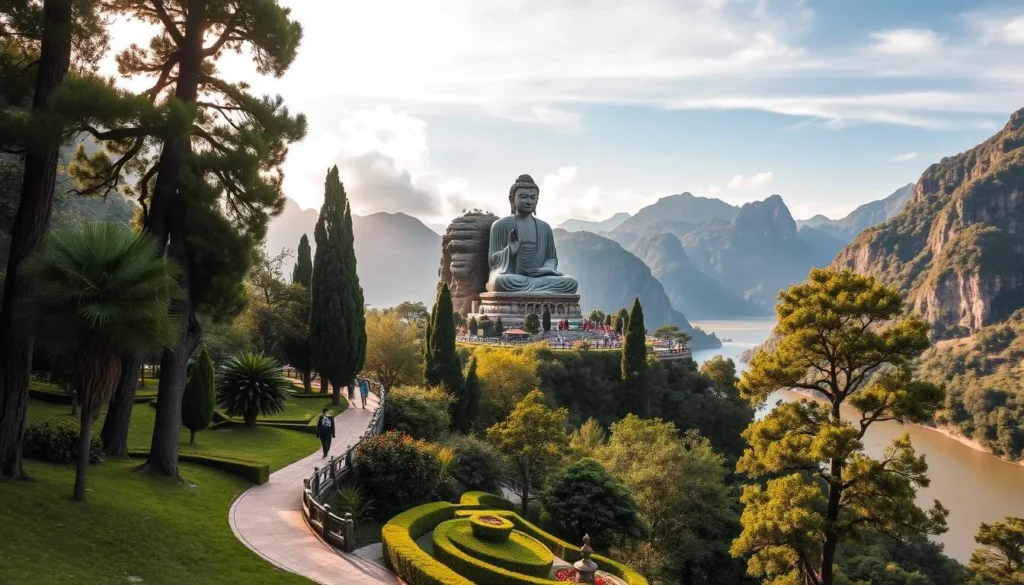
Best Time to Visit Leshan
The best time to visit Leshan depends on your preferences and what you want to experience. Spring (March to May) and autumn (September to October) are considered ideal due to the pleasant weather and fewer tourists. During these periods, the comfortable temperatures and lush landscapes make it perfect for exploring the city’s attractions.
- Summer brings lush greenery and vibrant landscapes, ideal for photography.
- Winter offers a serene landscape, sometimes with a light dusting of snow, creating a magical atmosphere.
Considering the weather and tourist seasons will help you plan your visit to Leshan effectively.
The Iconic Leshan Giant Buddha
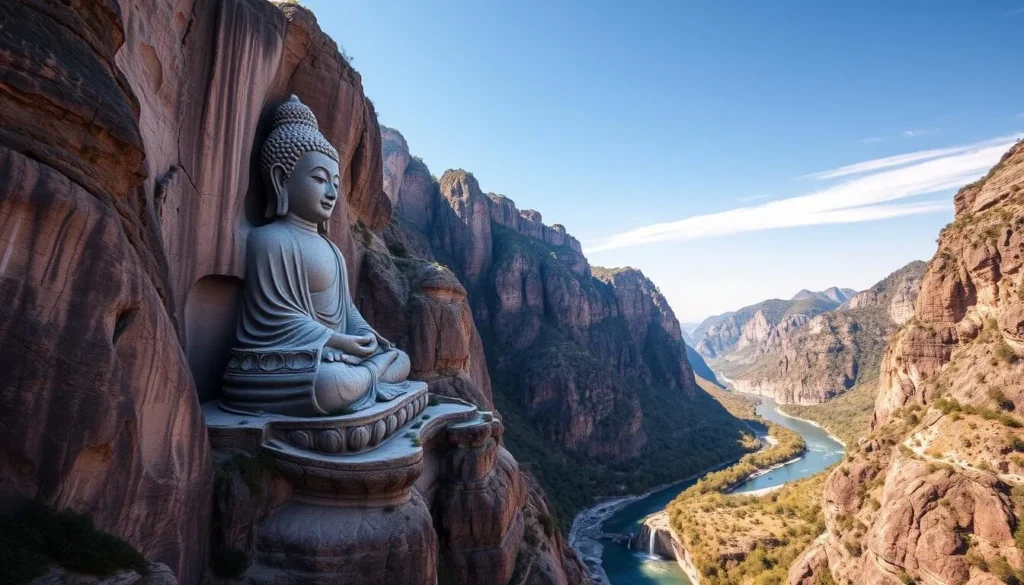
As you approach the Leshan Giant Buddha, the sheer scale of this ancient wonder becomes awe-inspiringly clear. The Leshan Giant Buddha is part of a larger scenic area that includes other attractions like Lingyun Temple, Wuyou Mountain, and the Oriental Buddha Park. This integration of natural beauty and historical significance makes the Leshan Giant Buddha a unique cultural experience.
History and Significance
The Leshan Giant Buddha, constructed during the Tang Dynasty, is not only a masterpiece of Buddhist art but also a testament to the ingenuity of ancient Chinese engineering. Standing at 71 meters tall, it is the largest Buddha statue in the world. The construction of the Giant Buddha began in 713 AD and took 90 years to complete, finally finished in 803 AD.
The significance of the Leshan Giant Buddha extends beyond its size; it represents a blend of religious devotion and cultural heritage. The Buddha is depicted in a serene and majestic posture, symbolizing peace and tranquility.
Viewing Options: Stairs vs. Boat
You have two primary options to experience the Leshan Giant Buddha: viewing it from the stairs alongside or taking a boat tour on the river. The stairs offer a closer, more immersive experience, allowing you to appreciate the intricate details of the Buddha’s construction. On the other hand, a boat tour provides a broader perspective, showcasing the Buddha’s enormity in relation to its surroundings.
Practical Tips for Visiting
To make the most of your visit, consider arriving early in the morning, before 9:00 AM, to avoid the crowds. Purchasing tickets in advance is also advisable, especially during peak travel seasons. Wear comfortable shoes, as the stairs can be steep and slippery. Allocate at least 3-4 hours to explore the Buddha and the surrounding attractions fully. Bringing water, sun protection, and a light rain jacket will ensure you’re prepared for the visit, regardless of the weather.
By following these tips and understanding the historical context of the Leshan Giant Buddha, you can enhance your visit and make the most of your time at this incredible site.
The Natural Wonder of Giant Sleeping Buddha

In Leshan, the majestic Giant Sleeping Buddha is a must-see natural attraction that harmoniously coexists with the man-made Giant Buddha. As you visit this place, you’ll be treated to a unique spectacle where nature and human craftsmanship blend together.
How to Spot This Natural Formation
The Giant Sleeping Buddha is a natural rock formation that resembles a Buddha lying on his back. To spot it, you need to be at the right vantage point. The formation is best viewed during certain times of the day when the light enhances its features.
Best Viewing Locations
Several locations offer stunning views of the Giant Sleeping Buddha. Key viewpoints include:
- The Leshan dock on the eastern side of the ancient city, where the outline is most distinct.
- A boat on the Minjiang River, allowing you to see both the carved Giant Buddha and the natural formation.
- The Leshan City Museum, which provides diagrams and photographs to help identify the formation’s features.
For the best perspective, visit in the morning. Local tour guides can also be invaluable in pointing out the exact angles and perspectives needed to fully appreciate this natural wonder, ensuring that your visit to this remarkable giant buddha site is memorable.
Exploring Mount Emei Scenic Area
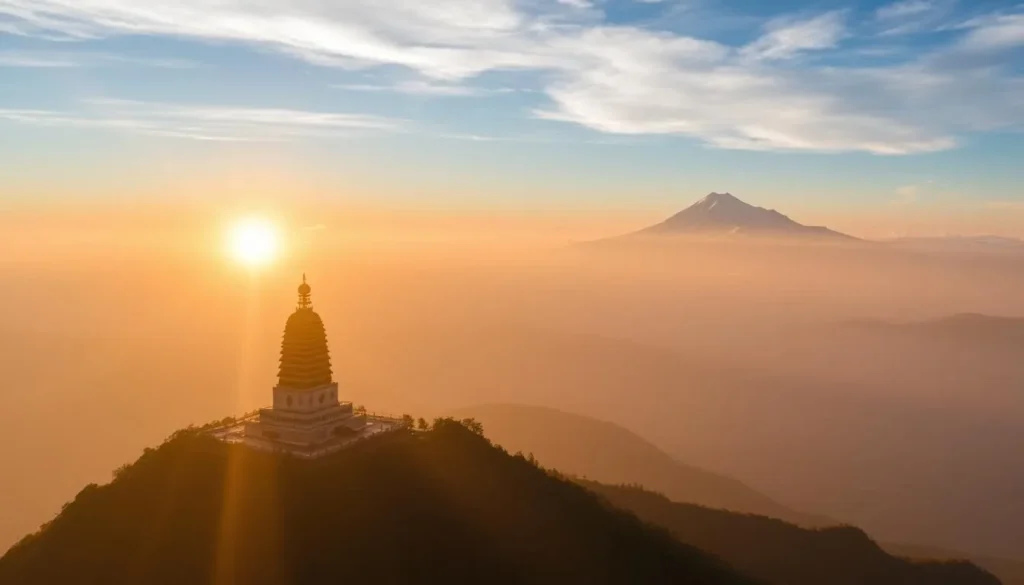
As you plan your trip to Leshan, China, consider a visit to the breathtaking Mount Emei Scenic Area. This UNESCO World Heritage site is a must-visit destination, offering a mix of natural beauty, cultural significance, and exciting activities throughout the year.
UNESCO World Heritage Highlights
Mount Emei is renowned for its stunning landscapes and rich cultural heritage. As a UNESCO World Heritage site, it boasts numerous significant landmarks, including temples, monasteries, and the iconic Golden Summit. The area is not only a spiritual haven but also a natural wonder, with diverse flora and fauna.
Golden Summit and Buddha Rays
The Golden Summit of Mount Emei is famous for its breathtaking sunrises and the spectacular “Buddha Rays” phenomenon, where the rising sun casts a halo-like glow around the shadows of viewers’ heads on the misty mountainside. This natural wonder is a rare and unforgettable experience.
Seasonal Attractions at Mount Emei
Mount Emei transforms dramatically with each season, offering unique experiences. In the spring, vibrant azalea blossoms paint the mountainsides. Summer is ideal for observing playful monkey populations. Autumn dazzles with golden foliage, while winter creates a magical snow-covered landscape where many trees remain green, a striking contrast not seen on other mountains. The Mount Emei Ski Resort near the Golden Summit offers high-quality Italian ski equipment and well-maintained slopes from October to March.
Cultural Immersion at Lingyun Temple
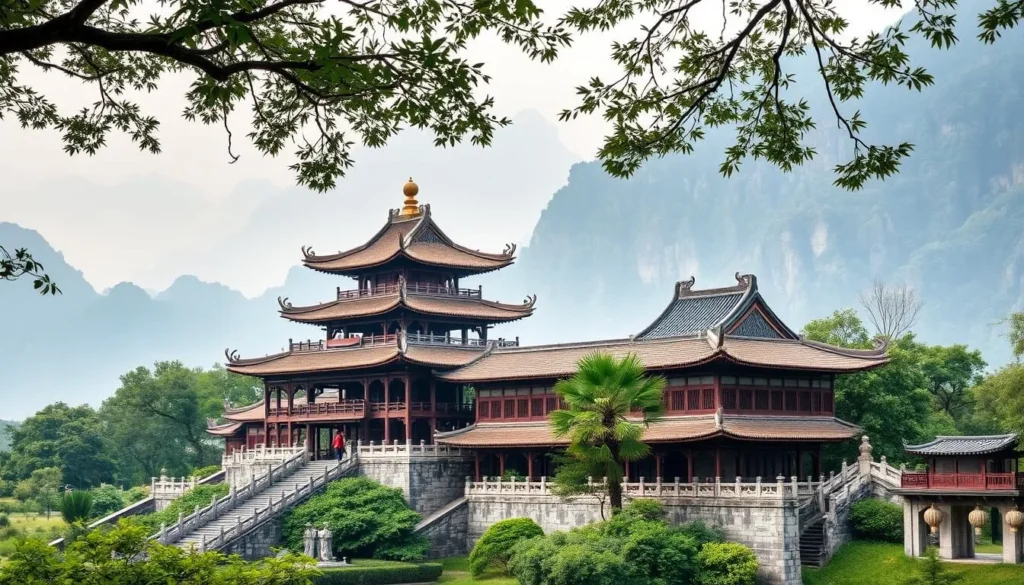
As you explore Leshan, a visit to Lingyun Temple offers a profound cultural immersion experience. This ancient temple is not only a significant religious site but also a place where you can witness the living traditions of Buddhism.
Ancient Architecture and Artifacts
The temple boasts impressive ancient architecture and houses numerous artifacts that reflect its rich history. You can observe intricate carvings, statues, and other relics that are integral to understanding the temple’s cultural significance. The architecture itself is a testament to the skills of ancient craftsmen.
Religious Significance and Practices
Lingyun Temple remains an active place of worship where Buddhist monks perform daily rituals and chant sutras. You can observe or participate in various Buddhist ceremonies, gaining insight into the living religious traditions. The temple is dedicated to Maitreya Buddha, the same figure depicted in the Giant Buddha statue, representing future salvation.
Visiting Wuyou Mountain
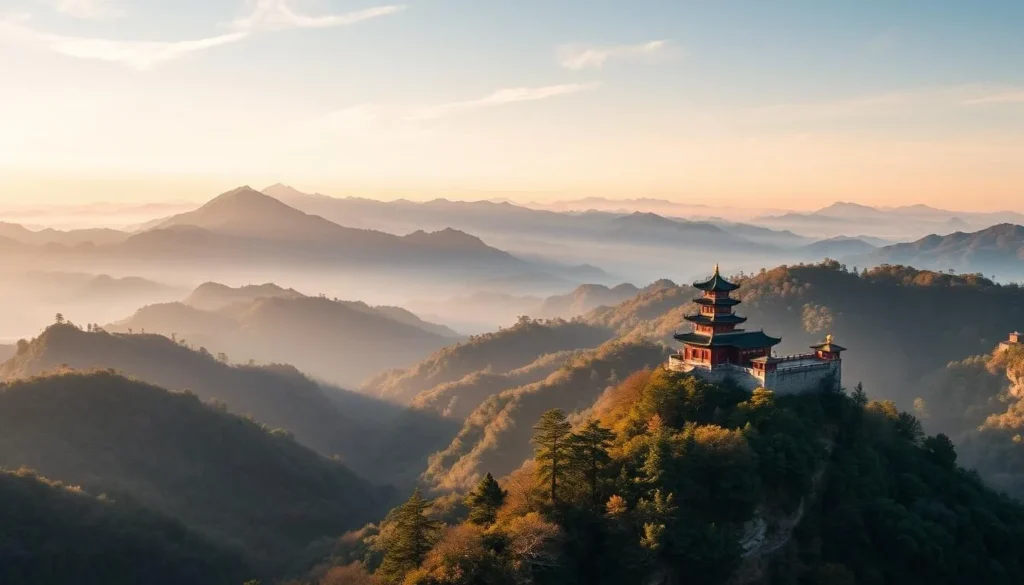
For those seeking a blend of nature and spirituality, Wuyou Mountain in Leshan is an ideal destination. Wuyou Mountain is not just a scenic spot; it’s an integral part of the Giant Sleeping Buddha natural formation, representing the Buddha’s head.
Scenic Pavilions and Viewpoints
Wuyou Mountain is adorned with scenic pavilions and viewpoints that offer breathtaking views of the surrounding landscape. The Jingyun Pavilion, in particular, is notable for forming the Buddha’s eyelashes when viewed from a certain angle, adding to the mountain’s spiritual charm.
Connection to the Giant Sleeping Buddha
The mountain’s unique features, such as its base forming the Buddha’s hair and the crown of trees on the peak constituting the Buddha’s facial features, create a profound connection to the Giant Sleeping Buddha. The most stunning view is from across the Minjiang River, showcasing the Giant Buddha seated at the heart of the Sleeping Buddha, a truly marvelous spectacle.
As you explore Wuyou Mountain, you’ll discover how different lighting conditions throughout the day change the appearance of the Sleeping Buddha’s “face,” with morning and late afternoon offering the most defined views. This natural wonder, combined with the man-made Giant Buddha, represents the Buddhist concept of interconnectedness, making Wuyou Mountain a must-visit destination for those interested in scenery and spirituality.
Exploring the Oriental Buddha Park
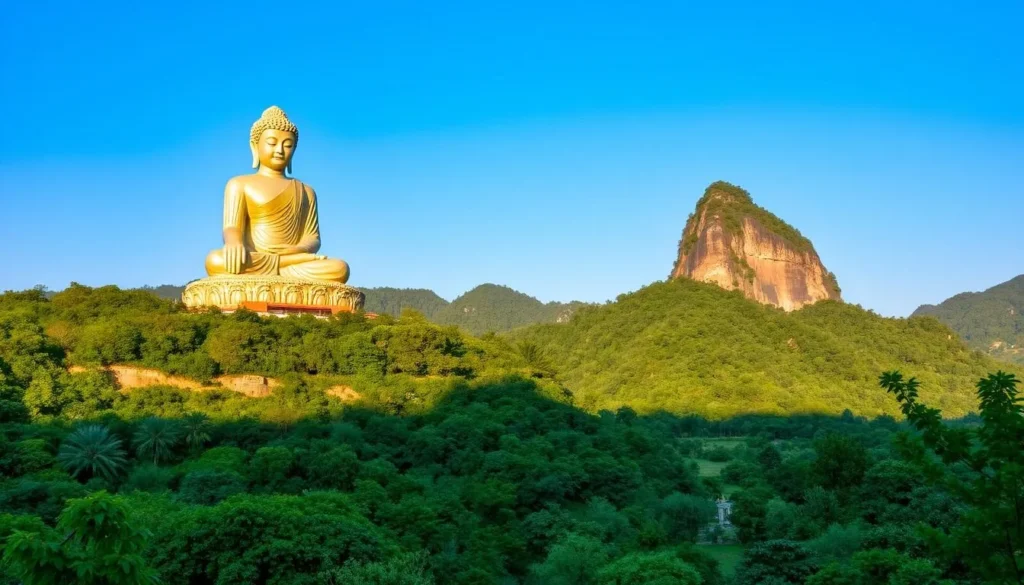
Nestled among the Leshan mountain ranges, the Oriental Buddha Park is a themed park that showcases an impressive collection of joss stone inscriptions and Buddhist sculptures. As you explore this serene destination, you’ll embark on a journey through the rich cultural heritage of the region.
Stone Inscriptions and Buddhist Art
The park is renowned for its extensive collection of stone inscriptions, which provide valuable insights into the history and significance of Buddhist art in the region. You’ll have the opportunity to admire intricate carvings and sculptures that reflect the artistic and spiritual traditions of Leshan.
Walking Routes Through the Park
The Oriental Buddha Park offers several well-marked walking routes that cater to different interests and time constraints. You can choose from a main circular path that takes around 2-3 hours to complete, an express route that highlights the park’s most significant pieces in about an hour, or an elevated mountain path that offers stunning views of the surrounding Leshan giant Buddha landscape. Throughout your journey, you’ll find peaceful rest areas with traditional Chinese pavilions where you can pause and appreciate the serene atmosphere of this spiritual park.
Uncovering History at Mahao Cave-Tomb Museum
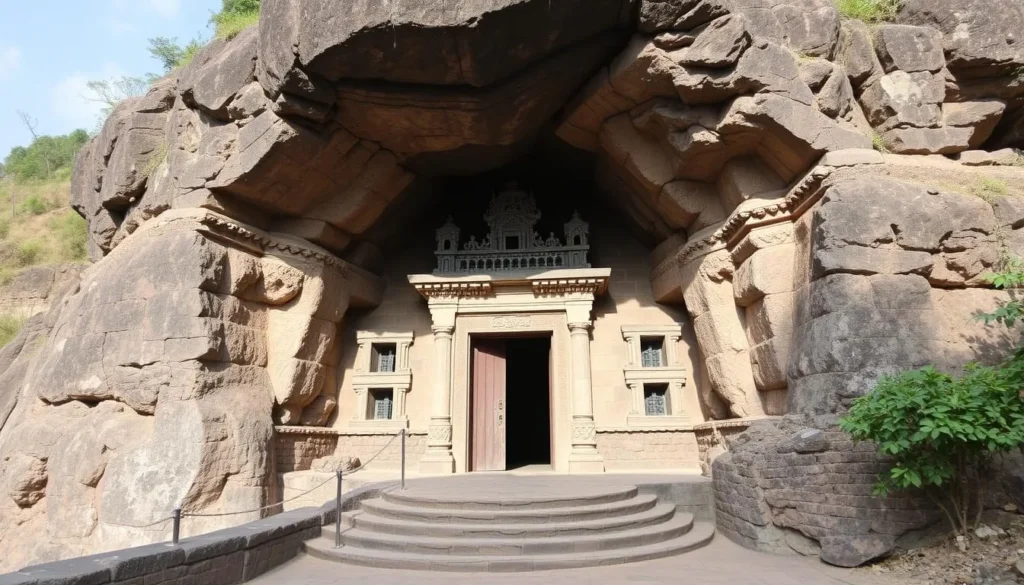
Uncover the ancient secrets of Leshan at the Mahao Cave-Tomb Museum. This museum is home to China’s earliest joss stone inscription, making it a significant archaeological site.
Ancient Joss Stone Inscriptions
The Mahao Cave-Tomb complex boasts over 500 tombs carved into the mountainside during the Han Dynasty (206 BCE-220 CE). The tombs feature wall paintings and carvings that depict scenes from daily life and mythological stories, providing a visual record of ancient Chinese society.
Archaeological Significance
Archaeological excavations at the site have unearthed numerous artifacts, including pottery, bronze weapons, and jade ornaments. These discoveries offer invaluable insights into ancient life in the Leshan region, making the museum a fascinating journey through time in this historic city.
As you explore the museum, you’ll gain a deeper understanding of Leshan’s rich history and its significance in the region, including its connection to the Leshan Giant Buddha. Visiting the Mahao Cave-Tomb Museum is a must-do experience when in Leshan.
Riding the Jiayang Steam Train
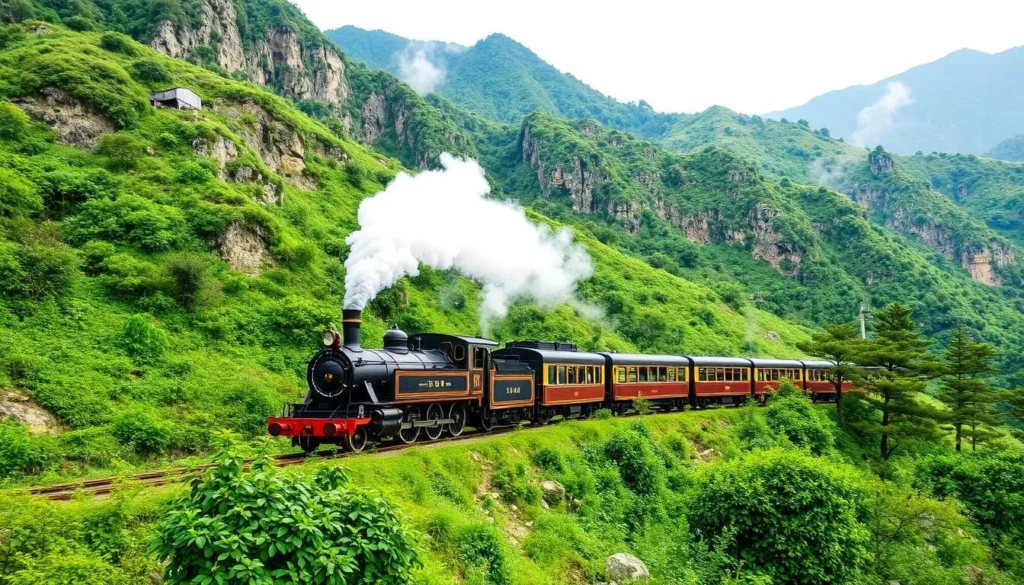
Experience the nostalgia of China’s railway heritage with a ride on the Jiayang Steam Train in Leshan. This historic train is one of the top things to do in the area, offering a unique journey through the picturesque landscapes of rural Sichuan.
A Journey Through Time
The Jiayang Steam Train route spans approximately 20 kilometers, showcasing breathtaking scenery as it climbs from the valley floor up into the mountains. As you travel through this one China railway gem, you’ll be treated to classic railway scenes that are sure to delight photographers and history buffs alike.
Scenic Route and Photo Opportunities
The train journey includes passages through narrow gorges, crossings over rushing mountain streams on stone bridges, and tunnels that frame perfect shots of the emerging train. With several scheduled stops, including the popular Bagou Station, you’ll have ample opportunities to capture memorable photos. For the best results, consider taking the morning departure when the lighting is softer and mist often hangs in the valleys, creating a dreamlike quality to your images.
Day Trips from Leshan
If you’re ready to explore beyond Leshan, several day trip options await you. The region is rich in cultural heritage and natural beauty, making it an ideal destination for travelers looking to experience more of what Sichuan has to offer.
Chengdu and the Giant Pandas
A day trip to Chengdu, the capital of Sichuan Province, is a must for any animal lover. The Chengdu Research Base of Giant Panda Breeding is a world-renowned conservation center where you can see giant pandas up close. Learn about the breeding programs and conservation efforts that are helping to protect this iconic species.

Dujiangyan Irrigation System
Another fascinating day trip from Leshan is to the Dujiangyan Irrigation System, a UNESCO World Heritage site located about 60 kilometers away. This ancient engineering marvel, dating back to 256 BCE, is still in use today, controlling the Min River’s water flow and irrigating the Chengdu Plain. Visitors can explore the system’s components, including the Fish Mouth Water Dividing Dam and the Flying Sand Fence, and walk across the Anlan Suspension Bridge for panoramic views.
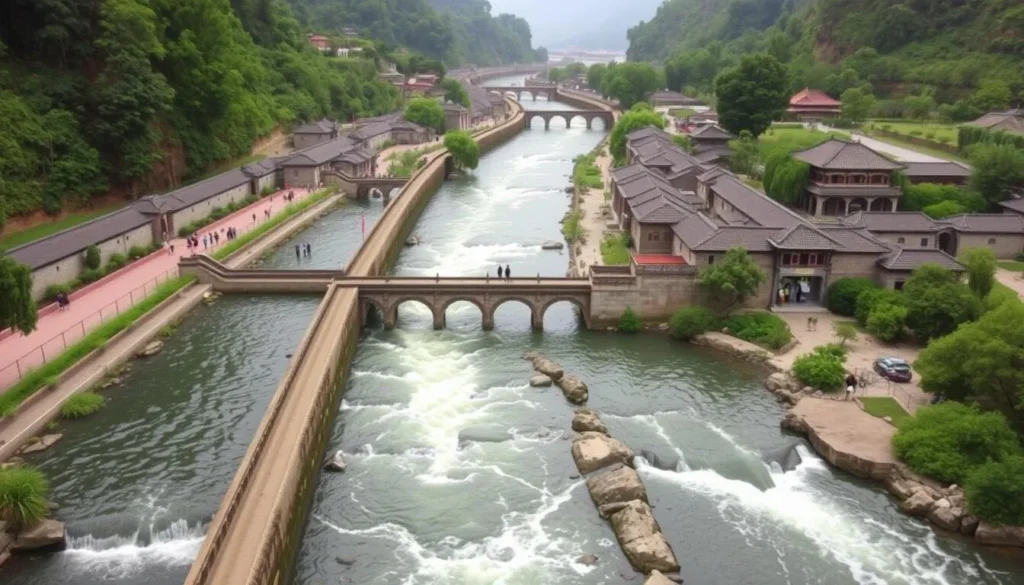
Combining a visit to the Dujiangyan Irrigation System with a trip to the nearby Chengdu Research Base of Giant Panda Breeding makes for a perfect day trip, showcasing both China’s cultural heritage and its conservation efforts.
Leshan’s Natural Landscapes
The natural beauty of Leshan is a treasure trove of exciting experiences, from serene rivers to majestic mountains. As you explore this region, you’ll discover a diverse range of landscapes that cater to different interests and preferences.
Rivers and Waterways
Leshan’s rivers and waterways are an integral part of its natural charm. The city’s scenic waterways, such as the Min and Dadu Rivers, offer stunning views and a glimpse into the region’s rich ecological diversity. You can take a leisurely boat ride or simply sit back and enjoy the serene scenery unfolding before your eyes.
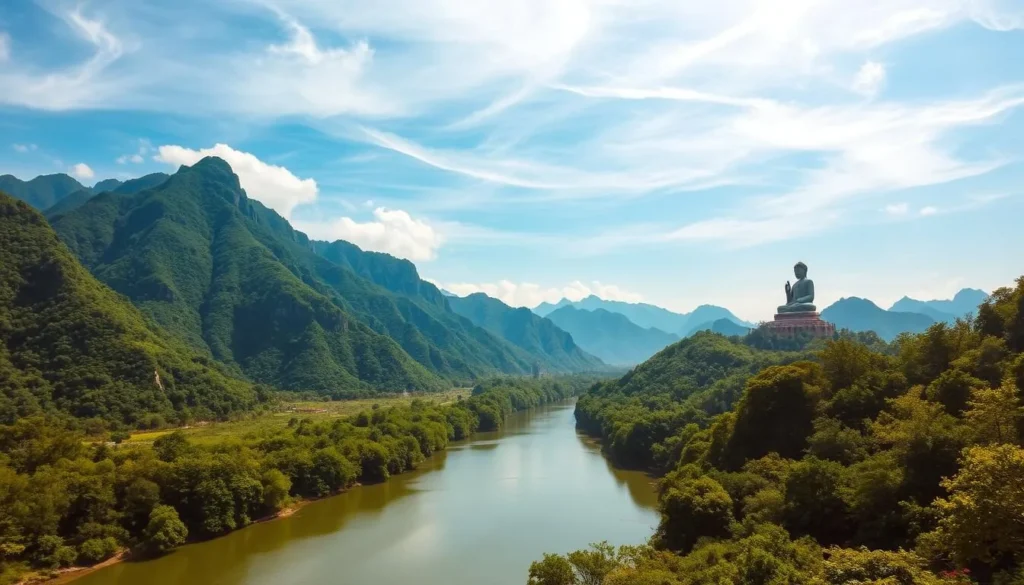
Mountain Scenery and Hiking Opportunities
For those who love the great outdoors, Leshan’s mountain landscapes are a hiker’s paradise. The region is surrounded by beautiful mountains, including the famous Mount Emei, which offer numerous hiking trails for all skill levels. As you hike through the trees and varied vegetation, you’ll be treated to breathtaking views and the chance to spot hidden waterfalls and natural hot springs. The leshan giant Buddha may be a famous attraction, but the natural beauty surrounding it is equally captivating.
Seasonal Activities in Leshan
As you explore Leshan, you’ll discover that each season brings its own unique charm and experiences. The city’s scenic areas, such as Mount Emei, are particularly popular among tourists.
Winter Snow Spectacles
Winter transforms Leshan into a serene landscape, with snow-covered mountains and frozen waterfalls creating a breathtaking scenery. You can enjoy the snow spectacles at Mount Emei, where the snow-capped peaks offer a picturesque backdrop for photography.
The winter season is also an excellent time to experience the local culture, with traditional festivals and events taking place in the city.
Spring and Autumn Highlights
Spring and autumn are two of the best times to visit Leshan, with mild temperatures and vibrant natural beauty. In the spring, Mount Emei is famous for its azalea blossoms, which bloom in May and June, creating a colorful display.
- Spring (April-May) brings azalea blossoms, transforming the mountainside into vibrant carpets of color.
- Autumn (September-October) offers comfortable temperatures and stunning foliage, making it ideal for hiking and photography.
- The “Buddha Rays” phenomenon at the Golden Summit is most frequently observed during spring and autumn.
Both seasons are perfect for spotting wildlife, with spring bringing active bird populations and autumn presenting opportunities to observe Tibetan macaques.
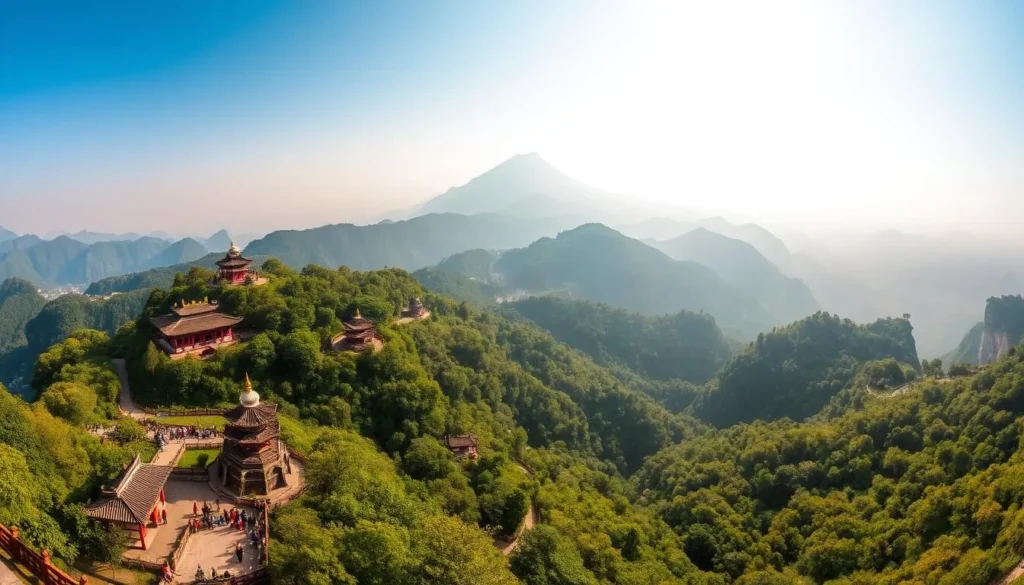
Local Cuisine and Dining Experiences
As you explore Leshan, you’ll discover that the local cuisine is a perfect blend of Sichuan spices and fresh local ingredients, making for a truly unforgettable dining experience. The city offers a variety of dining options, ranging from casual eateries to upscale restaurants, each serving dishes that showcase the rich flavors of Sichuan cuisine.

Must-Try Sichuan Dishes
Sichuan cuisine is renowned for its bold flavors and spicy dishes. In Leshan, you can try authentic Sichuan specialties such as hot pot, twice-cooked pork, and mapo tofu. These dishes are not only flavorful but also reflect the local culture and culinary traditions.
For an authentic taste, head to Jiading Street in downtown Leshan, where family-run eateries have been serving traditional recipes for generations.
Top Dining Spots
Leshan offers a range of dining spots that cater to different tastes and preferences. Riverside restaurants near the Leshan Giant Buddha offer stunning views and delicious local cuisine. For a more relaxed dining experience, the teahouses surrounding People’s Park are perfect for sampling local teas and snacks.
For those seeking a more upscale experience, luxury hotels in Leshan offer contemporary interpretations of Sichuan cuisine using premium ingredients.
Practical Travel Information
Planning a trip to Leshan, China, requires some practical information to make the most of your visit. Whether you’re drawn to the Leshan Giant Buddha or the broader China tour that includes this historic city, understanding your travel options is key.
Getting to Leshan
Leshan is accessible by various modes of transportation. The nearest airport is in Chengdu, from where you can take a high-speed train or bus to Leshan. Trains are a convenient option, with frequent services from major cities in China. If you prefer to drive, Leshan is connected to Chengdu and other nearby cities via highways.
Getting Around Leshan
Once in Leshan, getting around the city and its surrounding area is relatively straightforward. Taxis and public buses are readily available. For a more leisurely experience, you can also opt for a guided tour or rent a bike to explore the local scenery.
Accommodation Options
Leshan offers a wide range of accommodations to suit different budgets and preferences. For those prioritizing convenience, hotels near Jiading Street are ideal, offering easy access to both the Giant Buddha and downtown dining options. Mid-range hotels typically cost between 300-500 RMB per night. Budget travelers can find affordable hostels and guesthouses for as little as 100-200 RMB per night. If you’re visiting as part of a China tour that includes Mount Emei, consider staying at a monastery guesthouse for a unique cultural experience. Luxury seekers will find high-end resorts near Mount Emei, offering amenities like hot spring baths and fine dining, for 800-1500 RMB per night.
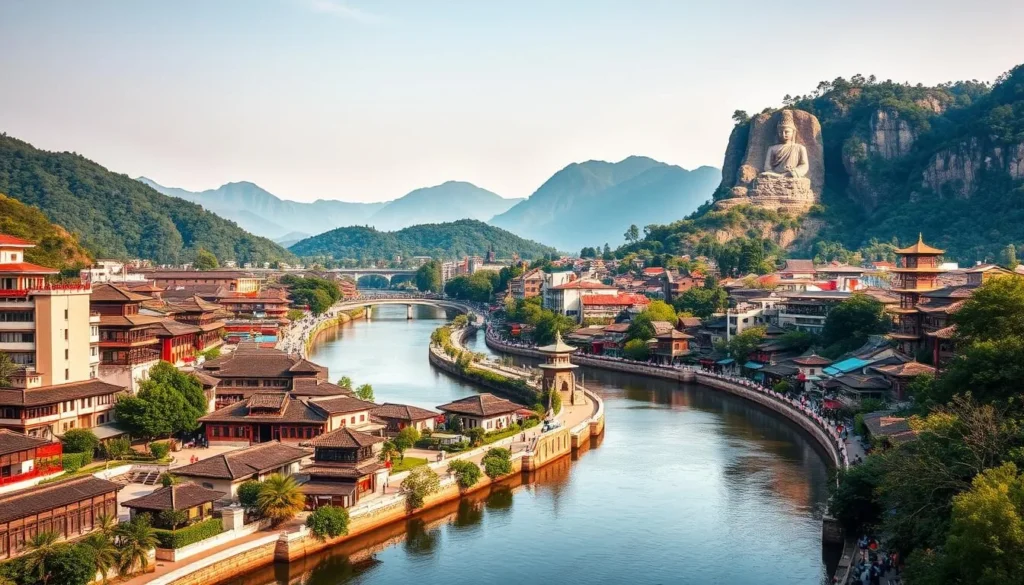
Best Leshan, China: Best Things to Do – Top Picks
Leshan, with its iconic Giant Buddha and stunning Mount Emei, is a city that seamlessly blends spirituality and natural beauty. Planning your visit to include the top attractions is essential to experiencing the best of what Leshan has to offer.
One-Day Itinerary
For a fulfilling one-day experience in Leshan, start early with a visit to the Leshan Giant Buddha, followed by a serene boat ride along the river. Afterward, explore the nearby Lingyun Temple to delve into the local culture and history. If time permits, a visit to Wuyou Mountain can provide a tranquil ending to your day.
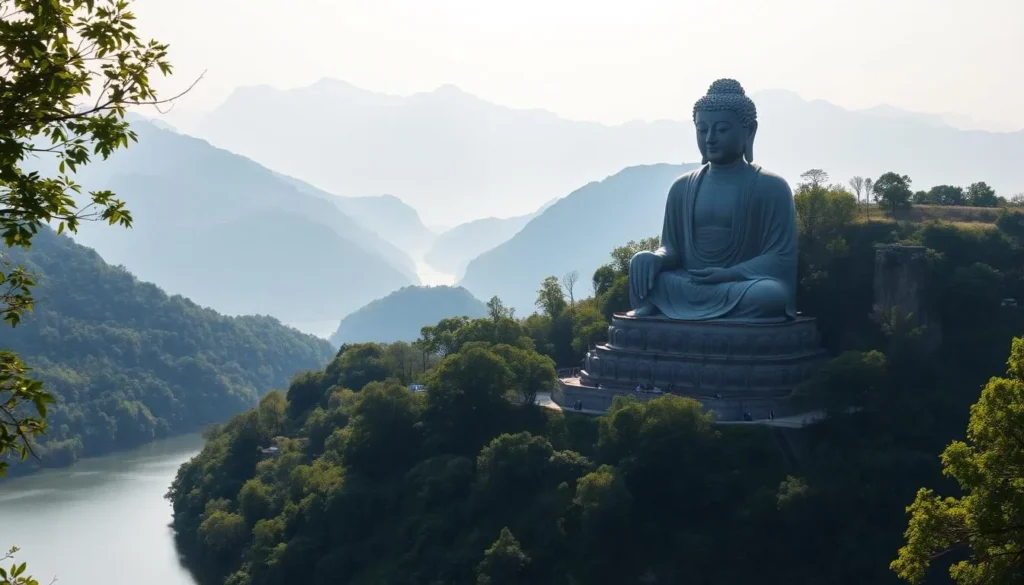
Two-Day Itinerary
A two-day itinerary allows for a more leisurely exploration of Leshan and its surroundings. On the first day, visit the Leshan Giant Buddha and Oriental Buddha Park. On the second day, dedicate your time to Mount Emei, taking the cable car to the Golden Summit to witness the breathtaking Buddha Rays phenomenon, if weather permits. Consider adjusting your itinerary to include a visit to the Chengdu Panda Base for a unique wildlife experience, especially if you’re combining Leshan with a China tour that includes Chengdu.
Conclusion
As you explore the wonders of Leshan, you’ll discover a city that seamlessly blends natural beauty and cultural heritage. The Leshan Giant Buddha and Mount Emei, both UNESCO World Heritage Sites, are testaments to the region’s rich history and spiritual significance.
Your journey through Leshan can include a visit to the Chengdu Panda Base as part of a broader China tour. Whether you’re marveling at the Giant Buddha or experiencing the breathtaking views from the Golden Summit of Mount Emei, Leshan promises an unforgettable experience.
Leshan’s charm extends beyond its famous landmarks to its riverside scenery, local cuisine, and warm hospitality. As you plan your trip, consider savoring Leshan’s layered experiences and seasonal variations, making it a destination worth visiting multiple times. With its unique blend of natural wonders and cultural treasures, Leshan is a traveler’s paradise that connects you with China’s ancient past and its natural beauty.
The above is subject to change.
Check back often to TRAVEL.COM for the latest travel tips and deals.
